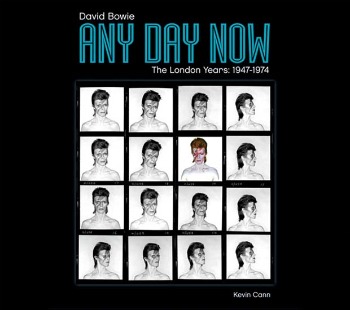The Rise and Rise of David Jones

I had a David Bowie obsession (and that’s by no means an exaggeration) that lasted until the fag-end of my twenties.
The photo at the top of this piece may seem to give the lie, but I was too young to appreciate the faultless 1970s recordings contemporaneously – the start of my Bowie years coincided with the release of 1983’s Let’s Dance and continued through the increasing ignominy of the 80s recordings (my highlight? Attending a Glass Spider Tour show at Wembley Stadium in 1987 and enjoying it). But my ardency didn’t begin to cool until the ‘trying too hard, Dad’ drum’n’bass stylings of 1997’s Earthling. And even then I thought 1. Outside was pretty decent.
It was the 70s recordings that preoccupied me, though, as anyone with a passing interest in post-Beatles art-rock will understand. Between the start of 1970 and the end of 1980, David Bowie couldn’t have put a foot wrong if he’d tried.
He turned out twelve(!) studio albums in that time, a geyser of inspiration and industry that spanned rock (glam or otherwise), singer/songwriter-y folk, numb white soul, Krautrock-inflected minimalism, New Wave angularity and, above all else, pop. Pop in the grand manner, the sort of pop that troubles the pop charts. I can’t count more than half-a-dozen non-essential tracks across the whole dozen albums. And that same period accounts for 37 singles, of which I’d contend one (1979’s Yassassin) is anything less than, in some fundamental way, moving.
Naturally, there was a fair amount of leg-work involved in turning Brixton’s David Jones into the frock-wearing ball of sexual confusion on the cover of 1970’s The Man Who Sold The World and thence into a world-famous icon of alienation and androgyny. It’s leg-work that’s all covered, in exhaustive detail (and accompanied by numerous rare and never-before-seen photographs) in Kevin Cann's Any Day Now: David Bowie The London Years 1947-1974 (Adelita, £24.99)
A book birthed from the same fine line between appreciation and obsession that delivered Ian MacDonald’s Revolution In The Head: The Beatles’ Records And The Sixties, Any Day Now starts at the very beginning (9am on Wednesday January 8th 1947 at 40 Stansfield Road SW9) and ends on Thursday 11th April 1974 with Bowie’s arrival in New York aboard the SS France. Cann simply tells the story of what happened in between.
From the banal (Monday 14th July, 1958: “David is interviewed by Bromley Council’s education officer…”), through the downright odd (Thursday 26th December 1968: “David performs at The Magicians’ Workshop, Falmouth, backed by drummer Keef Hartley. Hartley’s drumming career began as one of Ringo Starr’s successors in Rory Storm & The Hurricanes…”) to the already thoroughly documented (Tuesday 3rd July 1973, Hammersmith Odeon: “David steps up to the mic and says ‘Not only is this the last show of the tour, but it’s the last show we’ll ever do.’”), the tone never wavers. Here are the facts, as trite and as fascinating as can be.
Get the What Hi-Fi? Newsletter
The latest hi-fi, home cinema and tech news, reviews, buying advice and deals, direct to your inbox.
What raises Any Day Now above the level of a huge Wikipedia entry with interviews and pretentions are the photographs. There are hundreds of photographs in Any Day Now, each captivating in its own way.
There are lots of David Jones, schoolboy (who still has matching eyes), lots of Davy (or Davie) Jones, Mod About Town, and lots of David Bowie, superstar and possible alien from space. Here is George Underwood who, despite have once smacked young David in the face and paralysed the pupil in one of his eyes, is part of both The Konrads and The King Bees – two of Bowie’s early bands. Here is David with his Steve Marriott hairdo, his Mick Jagger hairdo, his Prince Valiant hairdo. Here’s David the mime artist.
A bit later on there are the media-baiting dresses, of course, the glam-rock excesses (the band may have been called The Spiders From Mars, but they looked defiantly like The Brickies In Make-Up) and the meetings with William Burroughs and Andy Warhol.
Almost as compelling is the memorabilia. Historical documents of popular culture don’t get much more intriguing than a flyer advertising a performance by something called David Bowie & The Buzz at The Rhythm & Bluesville Galaxy Club, Basingstoke. Or as nonplussing as a programme for the 1969 Malta International Song Festival (where Bowie performed When I Live My Dream). It’s with this sort of ephemera that Cann really lays bare his Bowie mania. How he’s party to the information that the blue suit Bowie wore for his performance in Malta was “bought from Just Men by Nikki of Tryon St, London SW3 – David removed some of the jacket’s white trim for his performance” is anyone’s guess.
So it should by now be obvious that the words ‘in-depth’ or even ‘comprehensive’ don’t begin to describe the slavish attention to detail brought to bear in Any Day Now. It’s certainly not for the mildly curious, but if you need to know that John Peel was the compere at the Birmingham Town Hall when Bowie supported Tyrannosaurus Rex there on 15th February 1969 (it was a Saturday), this is the book for you.
Simon Lucas is a freelance technology journalist and consultant, with particular emphasis on the audio/video aspects of home entertainment. Before embracing the carefree life of the freelancer, he was editor of What Hi-Fi? – since then, he's written for titles such as GQ, Metro, The Guardian and Stuff, among many others.
